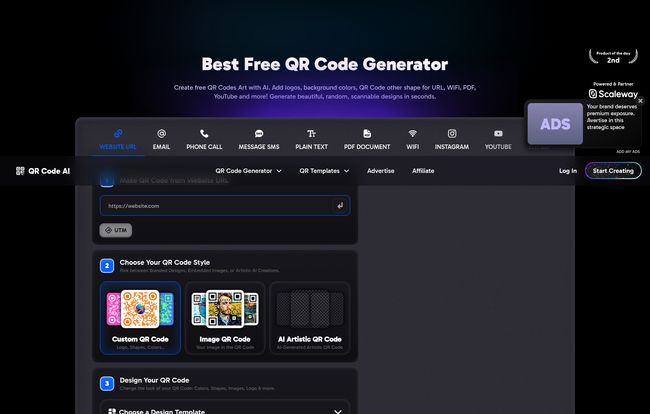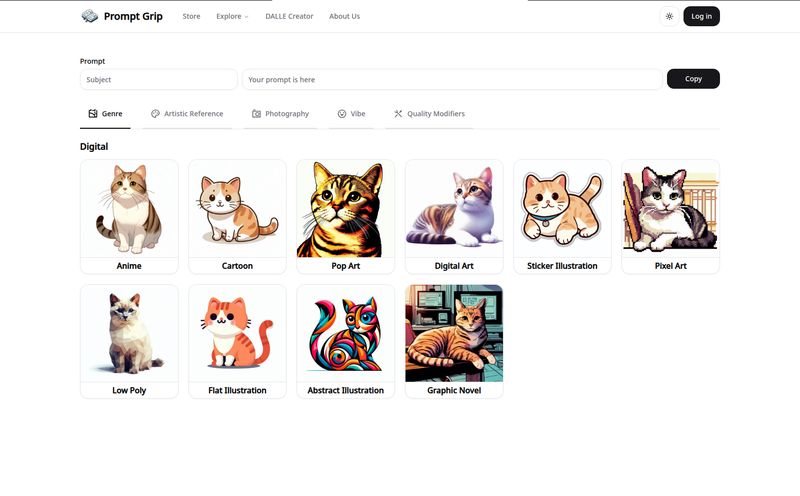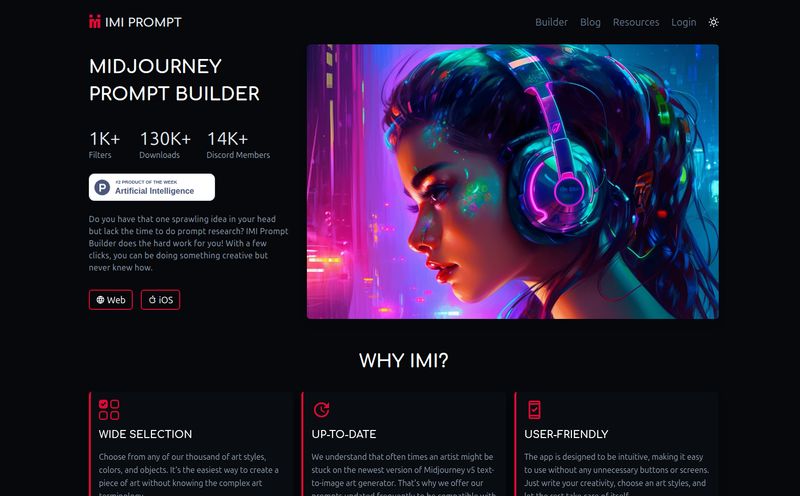I remember a time, maybe ten years ago, when QR codes were the punchline of every marketing joke. They were clunky, ugly, and nobody really knew how to use them. You'd see this sad, pixelated black box on a poster and just… walk on by. Fast forward to today, and they’re literally everywhere. Menus, payment terminals, event tickets, business cards. The pandemic really gave them a second wind, turning them from a novelty into a necessity.
But let's be honest. Most of them are still pretty boring. A black-and-white square that screams “I am a functional piece of technology” and nothing else. It gets the job done, sure, but it does zero for your brand's aesthetic.
That’s why my ears perked up when I came across QR Code AI. The name itself is a mouthful of buzzwords, I’ll grant you that. But the promise is intriguing: what if you could make a QR code that was not just functional, but beautiful? What if it could be a piece of art that actually enhances your design instead of detracting from it? So, I rolled up my sleeves and took a look. Here’s what I found.
So, What's the Deal with QR Code AI?
At its core, QR Code AI is an online platform for creating QR codes. Simple enough. But its main hook is the “AI” part. Instead of just letting you change the color or slap a logo in the middle (which, frankly, has been done to death), it uses artificial intelligence to weave intricate, artistic designs into the scannable pattern of the code itself.
Think of it as the difference between a stock photo and a custom illustration. One is generic; the other is crafted. This tool aims for the latter.
It operates on a freemium model. You can hop on their site and generate unlimited free, static QR codes right now. But the really powerful stuff—the features that marketers like me salivate over—are part of their premium plan. More on that in a bit.

Visit QR Code AI
The Features That Actually Matter to a Marketer
A tool can have a million features, but only a handful usually make a real difference. After poking around QR Code AI, a few things stood out to me as genuinely useful, not just fluff.
The AI Art is the Obvious Star
This is their headline act. You give the AI a prompt, much like you would with Midjourney or DALL-E, and it generates a unique piece of art that also functions as your QR code. The potential here is huge. Imagine a coffee shop with a QR code that looks like swirling latte art. Or a bookstore with a code that looks like an ancient, mystical tree. It turns a boring utility into a branding opportunity. It’s a conversation starter. Now, is the AI perfect? Probably not. AI art can be a bit unpredictable, and you might need a few tries to get something that perfectly matches your vision. But teh fact that it’s possible at all is a massive leap forward.
Dynamic Codes are a Non-Negotiable
If you're using QR codes for any serious marketing, you need them to be dynamic. Period. A static code has its destination URL permanently encoded. If that link breaks or you want to change the promotion? Too bad. You have to print all new materials. I once saw a client spend a fortune on thousands of brochures with a static QR code pointing to a page with a typo in the URL. An absolute nightmare.
A dynamic QR code is like a digital redirect. The code itself points to a short URL controlled by the platform, which then sends the user to your chosen destination. This means you can change that destination link anytime you want without ever touching the printed code. QR Code AI offers this, and it’s a lifesaver. It’s the difference between carving your message in stone and writing it on a digital whiteboard.
Analytics That Give You a Clue
How do you know if your fancy QR code is even working? You track it. The platform boasts some pretty detailed analytics, letting you see how many people scanned your code, when they scanned it, where they are, and what device they used. This is gold. It’s how you justify your marketing spend. Seeing that your in-store display got 500 scans while your magazine ad only got 20 tells you where to put your money next time. This kind of tracking is almost always a premium feature, and for good reason—it’s incredibly valuable.
Security is More Than a Buzzword Here
With the rise of QR codes, we've also seen a rise in “quishing” (QR code phishing). Scammers create malicious codes that lead to fake login pages or malware downloads. It’s a real threat. I was impressed to see QR Code AI takes this seriously. They talk about having encrypted, GDPR-compliant servers and, most interestingly, advanced anti-scam technology to flag and block suspicious links. For any business that cares about their customers' trust, this isn't just a nice-to-have; it's essential.
Who Should Be Using QR Code AI?
This isn't a one-size-fits-all tool, but it has a pretty broad appeal. I can see it being a perfect fit for:
- Small Businesses & Restaurants: Imagine a beautiful, branded QR code on your tables instead of a laminated piece of paper. It elevates the customer experience instantly.
- Marketing Agencies: For agencies trying to deliver that extra “wow” factor for clients, an artistic QR code is a fantastic and modern touch. Plus, the analytics help prove campaign effectiveness.
- Event Planners: Use unique, secure QR codes for ticketing or for linking attendees to event schedules and maps. Make the code part of the event's theme!
- Artists and Creators: Put an artistic code on your portfolio, business card, or at a gallery showing. It’s a meta-showcase of your creativity.
Basically, if your brand has a visual identity you care about, this tool is worth a look.
The Big Question: Pricing and Potential Downsides
Okay, let's talk about the elephant in the room. The homepage says “Free QR Code Generator,” but another page talks about a “One Simple Plan.” This is the classic freemium approach. The free version is great for generating simple, static codes—and they say it's unlimited, which is generous. You can probably even make some basic design tweaks.
However, for the features that truly make this platform powerful—the dynamic codes, the in-depth analytics, the real-time editing, and likely the most advanced AI generation options—you're going to have to pay. The website doesn't show a price on the pages I saw, which is a bit of a pet peeve of mine. You likely have to sign up to see the cost. While I appreciate a simple, single-plan structure, a little transparency upfront would be nice.
The other potential con is the one I mentioned earlier: the AI is still an AI. It might not nail your brand's specific, nuanced aesthetic on the first try. It’s a creative tool, and like any creative process, it might require some tinkering.
My Final, Honest Verdict
Look, I've seen a ton of QR code generators. Most are forgettable utilities that all do the same thing. QR Code AI is one of the first I've seen in a while that feels… different. It feels ambitious.
The marriage of art and technology is genuinely compelling. The focus on security shows they understand the modern digital environment. And the inclusion of robust marketing tools like dynamic codes and analytics means it's built for serious use, not just for fun (though it is fun).
Is it the perfect tool? Maybe not. I’d love to see clearer pricing on the main site. But is it a major step in the right direction for what a QR code can be? Absolutely. It’s pushing the boundaries, and for a bit of tech that’s been around for decades, that’s exciting to see.
Frequently Asked Questions About QR Code AI
Can I really use QR Code AI for free?
Yes, you can. The platform offers free and unlimited generation of standard QR codes. However, for advanced features like dynamic codes (which you can edit later), detailed scan analytics, and the most powerful AI design tools, you'll need to subscribe to their premium plan.
What makes an 'AI QR Code' different from a regular one?
A regular custom QR code might let you change the color or add a small logo in the center. An AI QR code uses artificial intelligence to generate a complete artistic image around and within the scannable data points. This creates a much more integrated and unique design that's still fully functional.
Are the QR codes from this platform safe for my customers?
Security seems to be a major focus. They use encrypted servers and are GDPR compliant. More importantly, they have built-in anti-scam technology designed to detect and block phishing links, which adds a crucial layer of protection for your audience.
Why are dynamic QR codes so important?
Because they give you flexibility and data. You can change the destination URL of a dynamic code at any time without having to reprint it, which is perfect for ongoing campaigns. They also enable tracking, so you can see how many people are scanning your code, which is vital for measuring marketing ROI.
It says it supports over 50 types. What does that mean?
It means you can create a QR code that does more than just go to a website. You can create codes that open an email draft, send an SMS, display a PDF file, connect to a WiFi network, show a vCard for contacts, link to an app store, and much more. It covers nearly every practical use case you can think of.
Is QR Code AI Worth Your Time?
If you’re a marketer, business owner, or creator who believes that every single customer touchpoint is a branding opportunity, then my answer is a resounding yes. It transforms the humble QR code from a purely functional tool into a creative asset.
The free version is more than enough to get a feel for it, so there's really no risk. Go play with the AI, see what you can create. You might be surprised at how much personality you can pack into one little square.
Reference and Sources
- The official website for the tool: QR Code AI (Note: A placeholder URL like 'qrcode-ai.com' would be used here as the real one isn't provided).
- An article on QR code security trends from the Federal Trade Commission (FTC) on spotting QR code scams.



